Every story always has two sides, one side for what the individual experienced, and one side for what actually happened.
When different people give their own perspective on an experience there are many differences in the details of the story, even when they seem to intersect with one another. These differences appear because every person has their own unique perspective on life. Each individual finds different details to focus on as they interpret the experiences of their lives in completely different manners. Everyone has their own personal intention behind the way that they share their ideas when explaining their side to an experience. The authors Malcolm Gladwell and Gloria Harris both have written articles which detail the experiences of the Greensboro Four. Both authors shape their side of the story in a precise style in order to provide the reader with a specific outcome. Each author's motivating intent is made clear by analyzing these author's pieces of literature and their points of intersection.
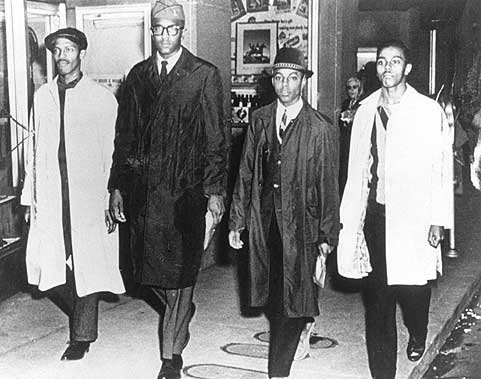
Source
The first point of intersection that occurs within the two pieces of literature appears in the introduction. Both pieces of writing begin by opening with a scene drawn directly from the experience of the Greensboro Four.
Malcolm Gladwell introduces his text, “Small Change: Why the Revolution Will Not Be Tweeted,” as a narrative with dialogue between one of the four students, Ezell Blair, and a waitress from Woolworth's diner where the Greensboro Four Sit-In occurred. Ezell politely asks for a cup of coffee, to which the waitress replies, “We don't serve Negroes here” (Gladwell 422). Gloria Harris brings in the setting of her article, “Breaking Barriers,” by writing, “The waitress refused to serve Joseph McNeil, David Richmond, Ezell Blair Jr., and Franklin McCain” (Harris np). Harris continues on by explaining that the four students were expecting such service, and he explains the rights of Black people at the time.
The way that Gladwell writes the dialogue exchanged between the student and the waitress acts as a way to bring the reader directly into the experience that the author is attempting to portray. The author focuses on a conversational exchange which would surely ignite the reader's emotions to try and represent an idea as being personal to the reader. In the introduction of the piece written by Harris, the author is plainly giving the reader the facts. By laying out the facts in a simple manner the reader is set-up for the ideas that the author is working to display rather than having the reading become mixed up in emotions.
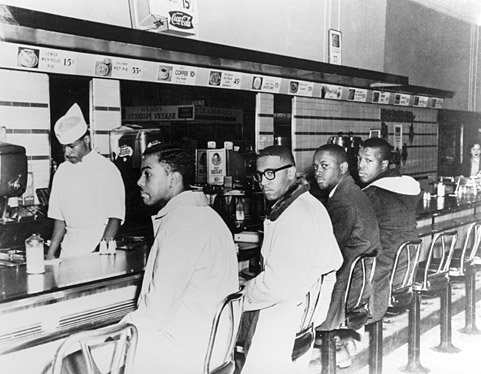
Source
The next point of intersection in these articles is the manner in which they both explain the effect of the Greensboro Four Sit-In.
Malcolm Gladwell focuses almost exclusively on how quickly the protests gained popularity and spread. His very first words in the article, “At four-thirty in the afternoon on Monday, February 1, 1960,” mention exactly when the students entered the diner (Gladwell 422). Gladwell writes about when the doors were locked, and when the students finally left. He writes, “By the next morning, the protest had grown to twenty-seven men and four women, most from the same dormitory as the original four” (423). In “Breaking Barriers” the author writes, “This "sit-in" was not the first such action, but it was the most significant,” (Harris np). He writes that this act brought on the name “The Greensboro Four” for the first four students to protest at Woolworth's because it sparked a mass movement in the students at the North Carolina Agricultural and Technical College.
Malcolm Gladwell puts a notable amount of weight on this particular point of intersection. The purpose of the author's article is to show the effect of grassroots type protests and how they have the most significant chance of effectively bringing about change. By focusing on the time it took to occur and how quickly it spread the reader is able to recognize the expediency with which the entire protest took place. While on the other hand, Harris places only a little bit of significance on this intersection and uses it only briefly to show that many people joined in because of these original four. The author's goal in this writing is to portray what the protesters experienced not how others had been affected to join them which is shown in the following intersection.
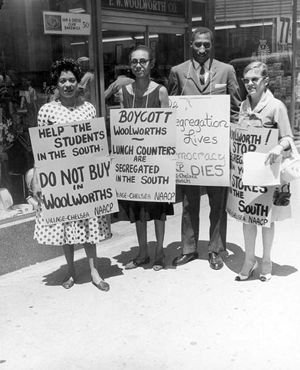
Source
The third point of intersection is the mode of delivery each author uses to describe what the experience of the Greensboro Sit-In was like.
Malcolm Gladwell quotes a political theorist Michael Walzer, “I asked every student I met what the first day of the sitdowns had been like on his campus...the answer was always the same: 'It was like a fever. Everyone wanted to go'” (qtd 424). The author puts very little weight on this intersection, but rather uses it as a supporting transition into the idea of the grassroots movements being the most effective for stimulating change. Harris uses this point of intersection as her most significant point as it most closely aligns with the goal of the author's work.
Although the protesters practiced nonviolence, white onlookers did not. Television cameras captured well-dressed, polite young men and women being pulled off stools, spat on, kicked, burned with cigarettes, and called ugly names. (Harris np)
Gladwell's momentary focus on the experience being likened to a fever spreading does well to strengthen the idea of how extraordinarily fast the protests spread when those who were most affected knew the protesters as their own peers. Just as the protest moved quickly, Gladwell brings up a strong point to draw in the reader's attention and continues on. Harris takes this time to appeal to the reader emotionally and sets the tone of her article. He continues on and explains how many more protesters joined and how they too were treated poorly and that, “Hundreds of students were arrested for trespassing, disturbing the peace, unlawful assembly, and disobeying police orders to move from their seats” (Harris np).
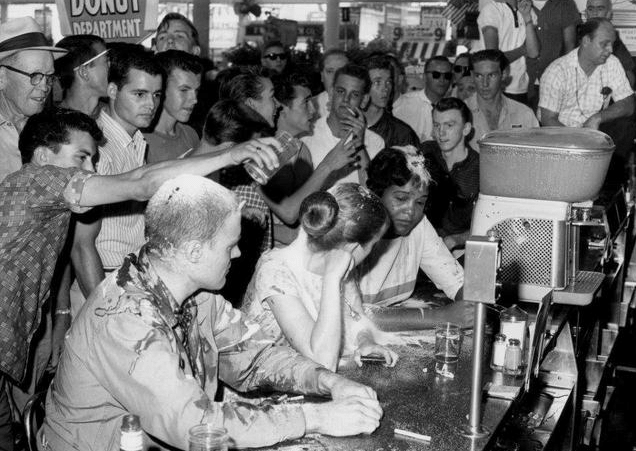
Source
The last point of intersection these two articles have in common is the means of which they each discuss how the protests spread.
Malcolm Gladwell's whole article is to explain the differences between grassroots, peer-to-peer movements and those which begin through various social media networking websites. “These events in the early sixties became a civil-rights war that engulfed the South for the rest of the decade – and it happened without e-mail, texting, Facebook, or Twitter” (Gladwell 424). The author uses this point to move into the rest of his piece of literature where he breaks down the effectiveness of social media versus the effectiveness of grassroots movements. Gloria Harris mentions that the Southern Christian Leadership Conference (SCLC) sent a representative to organize a Sit-In Leadership conference named Ella Baker. Baker pushed her belief in grassroots movements and helped students to form their own organizations which worked together to help desegregate lunch counters, movie theaters, amusement parks, beaches, libraries, and hotels almost 100 Southern cities by the fall of 1960 (Harris np).
Gladwell's wording brings a sense of wonderment to the reader that such a powerful movement was able to spread so vastly in such a short amount of time without the use of social media but only by the word of mouth. The author does a marvelous job at preparing the reader for the rest of his article by setting it up with the expediency of which the Greensboro Four Sit-Ins effected the rest of the South. Harris puts only a little bit of weight on the grassroots movement, but does a great job of ensuring that it is impressed upon the reader that the movement was strictly peer-to-peer.
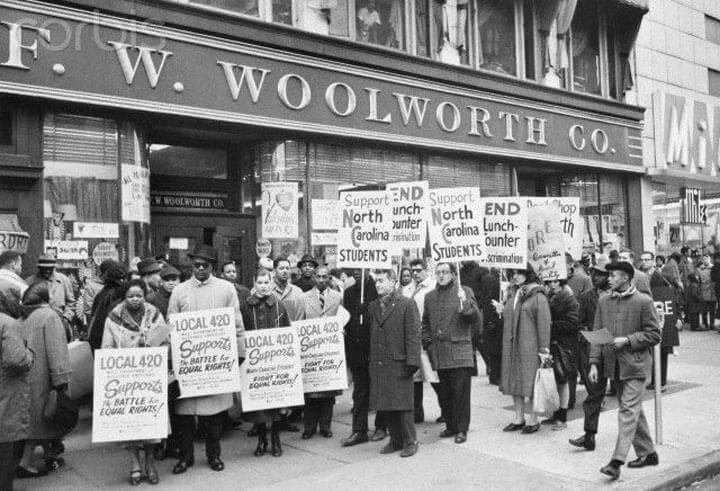
Source
Malcolm Gladwell uses the Greensboro Four in his article “Small Change: Why the Revolution Will Not Be Tweeted” as a powerful anecdotal attempt to appeal to the reader's emotion. By stating the facts about how quickly the protests spread and beginning with strong dialogue the author is able to deliver his message in a clear and concise manner which appeals to the reader on a personal level. Gloria Harris uses the same experience but shapes it in such a way to show that the fearlessness of the Greensboro Four led many others to follow suit. Their courageousness helped pave the way for future youth to know their own strength.
By analyzing, and comparing and contrasting these two essays it is shown how two different authors are able to chose certain details and write about them in their own language in order to provide a specific desired outcome for the their target audience while writing about the same idea or instance.
Any topic or situation is able to be spun in any direction that the author wishes. While these examples do not necessarily show how stories can be manipulated in a negative or harmful way, such instances are all too familiar to our societies. When researching into a situation being reported on, be certain to look for multiple perspectives to be able to try and reach an educated opinion.
Gladwell, Malcolm. “Small Change: Why the Revolution Will Not Be Tweeted.” The Writer's Presence: A Pool of Readings, edited by Donald McQuade and Robert Atwan, Eighth edition, Bedford/St. Martin's, 2015, pp 422-431.
Harris, Gloria. “Breaking Barriers.” Cobblestone magazine, Feb2015, Vol. 36 Issue 2, p14-15.
LOVELAUGHTER&&XHAOS
PALPABLE POPE Ypyskypo Skwyrl, the Y'sas
Loser of Found Souls, Temple of Appled Thought
Erisian Ataxia Troupe

If you enjoyed this post, feel free to follow me and check out a few of the others that I have authored!
One toke away from relief! [Cannabis Strain Review: Lime Warp High THC High CBD]
Do you feel me? Or do you feel sorry for me? [Empathy & Sympathy: Dabbing with a Mage Episode 14]
Colors, colors, COLORS EVERYWHERE! [Sneak peak into DIY Tie Dye Mandala Tapestry]
- Who put this uppercase 'T' in my truth? [Subjective & Objective Reality: Dabbing with a Mage Episode 13]
- A Message From the Universe to You [An original poem]
- Western & Alternative Medicines [Wake and Bake!][Dabbing with a Mage Episode 12]
- Enveloped In Life [Original Poem]
- Did you say there's bugs in my food? [The human micro-biome and probiotics: Dabbing with a Mage Episode 11]
- How to Add a Multiplier to Your Steemit Rewards!
- I closed my eyes, but my thoughts won't stop, what the hell?! [What is Meditation? : Dabbing with a Mage Ep 10]
- Stoner Sounds for Stoner Situations [A short list of albums great for listening to when smoking cannabis]
- Open Mic Week 36: Kibbles and Chimera (Original song)
- Are You Worthy of Breath? [Original Poetry]
